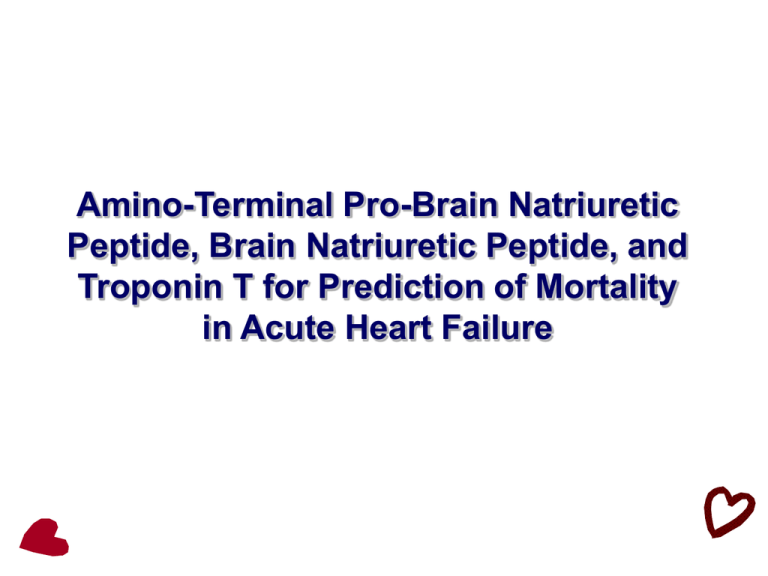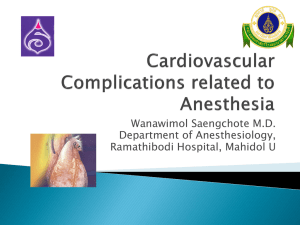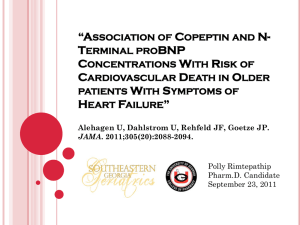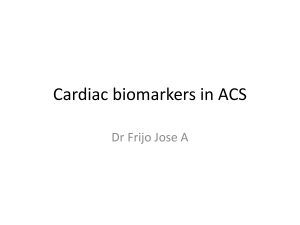Cardiac marker - Lab Test Consult
advertisement

Amino-Terminal Pro-Brain Natriuretic Peptide, Brain Natriuretic Peptide, and Troponin T for Prediction of Mortality in Acute Heart Failure HEART FAILURE CAD CARDIAC DISEASES HYPERTENSION CARDIOMYOPATHY CONGENITAL & CARDIAC VALVULAR HEART HYPERTROPHY DISEASE ARRHYTHMIA A Cardiac Marker is definded as a clinical laboratory test useful for detecting AMI or minor myocardial injury. Most useful when patients have nondiagnostic ECG tracing. Markers differ in their… 1. Location in/out of the myocytes 2. Release kinetics of damage 3. Clearance from the circulation 4. Chemical Structure and conformation Myocardial necrosis (ACS markers) Ischemia Hypervolemic status Apoptosis Antherosclerotic Inflammatory process Genetics Thrombogenesis Plaque rapture Renal Function An Ideal Marker for Myocardial Injury (action in acute conditions) ECG Abnomality Marker 0-4hrs No Rapid 4-48hrs No Serial monitoring >48hrs No Persist long shortfall Anytime Yes Monitoring therapy Time after chest pain thrombolytic An Ideal Marker for Myocardial Injury (in chronic conditions) Predicting morbidity and mortality Release of Cardiac Markers in Myocardial Infarction PROTEIN MARKERS Myoglobin Oxygen binding protein of cardiac and skeletal muscle 1. Location in/out of the myocytes Cardiac and skeletal muscle nonspecific Myo / (HFABP & CK-MM or CA) ratio helps to differentiate 2. Release kinetics of damage Cytoplasmic rapid release 3. Clearance from the circulation Renal GFR increases Myo 4. Chemical Structure and conformation small rapid release ENZYME MARKERS Creatine Kinase MB isoenzyme Activity and Mass 1. Location in/out of the myocytes Cardiac (10-20% of total CK activity) and skeletal muscle (2-5% of total CK activity) nonspecific % CK-MB (mass:total CK activity) helps to differentiate 2. Release kinetics of damage Cytoplasmic fast release 3. Clearance from the circulation kidneys GFR increases CK-MB ENZYME MARKERS Creatine Kinase MB isoenzyme Activity and Mass 4. Chemical Structure and conformation At least 4 isoforms Only two forms CK-MB1 and CK-MB2 used diagnostically PROTEIN MARKERS Cardiac Troponin I and T Regulatory proteins of myofibril 1. Location in/out of the myocytes Cardiac and skeletal muscle isoforms 2. Release kinetics of damage 94-97% myofibril, 3-6% cytoplasmic delayed release, persist 3. Clearance from the circulation PROTEIN MARKERS Cardiac Troponin I and T Regulatory proteins of myofibril 4. Chemical Structure and conformation cTnI has additional posttranslational 31-aa NT residues than skeletal muscle TnI, very specific cTnT has additional posttranslational 11-aa NT residues than skeletal muscle TnT, also expressed in skeletal muscle under certain circumstances Complex of three subunits C(calcium binding), I (inhibitory) and T (tropomyosin-binding): association/dissociation Mutiple modifications: C and N terminal degradation Phosphorylation Oxidation, reduction PEPTIDE MARKERS NT-pro BNP and BNP Regulatory hormone in response to cardiac stresses, particularly cardiac stretch 1. Location in/out of the myocytes Heart ventricles and brain→ nonspecific 2. Release kinetics of damage No storage in cardiomyocytes Not a marker for acute conditions 3. Clearance from the circulation BNP: Receptor-mediated clearance (neutral endopeptidase) NT-proBNP: kidneys GFR increases NT-pro BNP PEPTIDE MARKERS NT-pro BNP and BNP Regulatory hormone in response to cardiac stresses, particularly cardiac stretch 4. Chemical Structure and conformation preproBNP (134aa) myocyte proBNP(108aa) NT-proBNP(1-76aa) Signal peptide (26aa) LV stretch Wall tension BNP-32 (77-108aa) MISCELLANEOUS MARKERS hsCRP Serum amyloid protein A Cytokines sCD40 ligand Myeloperoxidase Phospholipase A2 Antherosclerotic process Inflammatory responses oxLDL Placental growth factor Choline (phospholipase D) Isoprostanes Homocysteine Adhesion molecules Nourin MISCELLANEOUS MARKERS Unbound free fatty acid Ischemia modified albumin Ischemia Urinary thromboxane Thrombogenesis Secreted platelet granular substances Tissue plasminogen activator antigen Matrix metalloproteinases Plaque Pregnancy associated plasma protein A rapture MISCELLANEOUS MARKERS Heart-type cytoplasmic fatty acid-binding protein (H-FABPc) Glycogen phosphorylase isoenzyme BB (GPBB) Early Detection of MI? Acute Coronary Syndrome ESC/ACC Cardiac troponin I or T CK-MB mass Total CK 1. Early release kinetics similar to CK-MB Although none of them sensitive enough for early detection. 2. Long interval of increase, replaced LD in detecting late-presenting patient. Although can not differentiate new and recurrent MI. 3. Cardiac tissue specificity Heart Failure Pathophysiological condition in which an abnormality of cardiac function is responsible for the failure of the heart to pump sufficient blood to satisfy the requirements. 1. Impairment from ACS 2. Cadiac stiffness 3. High output heart failure BNP & NT-proBNP Insufficient evidence to show after therapy High sensitivity Low specificity Diagnosis of HF Monitoring HF therapies BNP & NT-proBNP Prognosis of CAD, HF Independent predictor Insufficeint accuracy to be a screening test Comparison & Combination with other markers AUC 0.67 P=0.05 0.61 0.68 0.67 P=0.35 0.64 0.61 6mo 1yr 6mo 1yr NT-proBNP < < < > > < BNP > > << <> >< >> NT-proBNP << <> >< >> BNP Hazard=1/(N-K+1)









